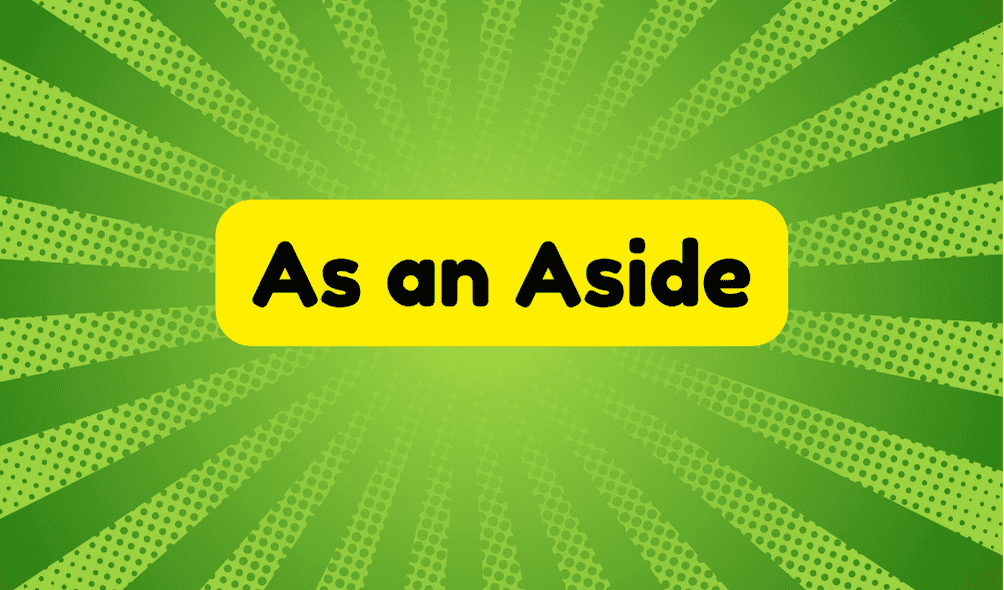The phrase "as an aside" introduces additional comments or thoughts in conversations, enriching discussions. Its origins trace back to speech and literature, reflecting character insights in classical plays. Commonly used in expressions like "as an aside" or "make an aside," it serves as a valuable conversational tool. However, overuse can lead to meandering discourse. Understanding its nuances allows for more engaging exchanges, hinting at the deeper significance of such linguistic elements in everyday communication.
Synonyms
When discussing the term "aside," it is helpful to contemplate its synonyms, which can provide a clearer understanding of its meanings and usage. Recognizing these alternatives illuminates its role in storytelling and discussions.
- Tangent
- Remark
- Comment
- Observation
- Footnote
Each synonym unfolds a layer of indirect communication, often implying thoughts not meant for everyone. These terms enhance narrative depth, offering insight into characters' motivations. Consequently, exploring synonyms for asides is essential, as it grounds their usage in real-world contexts, fostering a richer comprehension of both dialogue and storytelling in creative expressions.
Example of Sentences
Exploring examples of sentences that utilize the term "aside" reveals its flexibility and practical application in everyday conversation. This phrase often accompanies interesting anecdotes or casual remarks, adding depth to discussions. Consider the following examples:
- "As an aside, could you pass the salt?"
- "That was a great concert; as an aside, did you catch their backstage antics?"
- "I finished the project, but as an aside, I need more time for revisions."
- "As an aside, my dog thinks he's the neighborhood watch."
- "She mentioned, as an aside, that she enjoys painting."
These sentences highlight how "aside" enhances communication subtly yet effectively.
Origin
The origin of the term "aside" is somewhat obscure, lacking a definitive starting point that can be pinpointed with certainty. This term has emerged within a historical context that intertwines with both everyday speech and formal literature, emphasizing its literary significance. The term's evolution can be seen in various forms throughout classical plays, where it served as a crucial tool for character expression.
| Historical Context | Literary Significance | Usage Examples |
|---|---|---|
| Everyday conversations | Enhances emotional depth | Classical theater |
| Shift in dialogue | Reflects inner thoughts | Modern storytelling |
| Rhetorical devices | Engages audience | Informal chats |
Collocations
Collocations associated with the term "aside" reveal its multifaceted role in both spoken and written language. This word efficiently intertwines with various phrases that exemplify its contextual use, considerably within discussion techniques and casual remarks. Key collocations include:
- As an aside
- Make an aside
- Aside from
- Take aside
- Remarks as an aside
These combinations not only enrich communication but also underscore the subtlety in conveying thoughts. Understanding these collocations can lead to more effective conversations, challenging the notion that casual remarks lack depth. Therefore, leveraging "aside" can add layers to discussions that are often overlooked.
How to Use in Everyday Language
Incorporating the term "aside" into everyday language can markedly enhance communication, yet many may overlook its value. Using "aside" enriches casual conversations, allowing individuals to add informal remarks without derailing the main topic. For example, someone might say, "As an aside, did you hear about the new café opening?" This technique subtly shifts focus, bringing in additional context while maintaining the flow. However, it is crucial to use it judiciously; overusing "aside" may lead to confusion or seem scattered. Ultimately, recognizing its potential can transform simple exchanges into more nuanced discussions, fostering deeper connections and understanding among peers.
Why Is It Still Relevant Today?
Even as language evolves, the concept of making remarks "asides" remains relevant in today's communication. In modern communication, such informal remarks often enhance discussions, adding depth without overshadowing the main topic. Their cultural significance lies in fostering connections, allowing individuals to share insights or humor discreetly. However, in an age dominated by digital interactions, the subtlety of an aside risks being lost, as messages can lack tonal nuances. This raises questions about authenticity and engagement. Despite these challenges, the practice persists, underscoring its enduring value in both personal and professional dialogues, where context and camaraderie are essential for meaningful exchanges.







